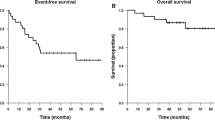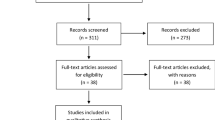Abstract
Non-invasive loco-regional electro-hyperthermia (EHT) plus alkylating chemotherapy is occasionally used as salvage treatment in the relapse of patients with high-grade gliomas. Experimental data and retrospective studies suggest potential effects. However, no prospective clinical results are available. We performed a single-center prospective non-controlled single-arm Phase I trial. Main inclusion criteria were recurrent high-grade glioma WHO Grade III or IV, age 18–70, and Karnofsky performance score ≥70. Primary endpoints were dose-limiting toxicities (DLT) and maximum tolerated dose (MTD) with the combined regimen. Groups of 3 or 4 patients were treated 2–5 times a week in a dose-escalation scheme with EHT. Alkylating chemotherapy (ACNU, nimustin) was administered at a dose of 90 mg/m2 on day 1 of 42 days for up to six cycles or until tumor progression (PD) or DLT occurred. Fifteen patients with high-grade gliomas were included. Relevant toxicities were local pain and increased focal neurological signs or intracranial pressure. No DLT occurred. In some patients, the administration of mannitol during EHT or long-term use of corticosteroids was necessary to resolve symptoms. Although some patients showed responses in their primarily treated sites, the pattern of response was not well defined. EHT plus alkylating chemotherapy is tolerable in patients with relapse of high-grade gliomas. Episodes of intracranial pressure were, at least, possibly attributed to EHT but did not cause DLTs. A Phase II trial targeting treatment effects is warranted on the basis of the results raised in this trial.


Similar content being viewed by others
References
Roizin-Towle L, Pirro JP (1991) The response of human and rodent cells to hyperthermia. Int J Radiat Oncol Biol Phys 20:751–756
Armour EP, McEachern D, Wang Z, Corry PM, Martinez A (1993) Sensitivity of human cells to mild hyperthermia. Cancer Res 53:2740–2744
Magin RL, Johnson RK (1979) Effects of local tumor hyperthermia on the growth of solid mouse tumors. Cancer Res 39:4534–4539
Streffer C (1988) Aspects of metabolic change after hyperthermia. Recent Results Cancer Res 107:7–16
Hermisson M, Wagenknecht B, Wolburg H, Glaser T, Dichgans J, Weller M (2000) Sensitization to CD95 ligand-induced apoptosis in human glioma cells by hyperthermia involves enhanced cytochrome c release. Oncogene 19:2338–2345
Komata T, Kanzawa T, Nashimoto T, Aoki H, Endo S, Nameta M, Takahashi H, Yamamoto T, Kondo S, Tanaka R (2004) Mild heat shock induces autophagic growth arrest, but not apoptosis in U251-MG and U87-MG human malignant glioma cells. J Neurooncol 68:101–111
Zolzer F, Streffer C (2000) Quiescence in S-phase and G1 arrest induced by irradiation and/or hyperthermia in six human tumour cell lines of different p53 status. Int J Radiat Biol 76:717–725
Hermisson M, Strik H, Rieger J, Dichgans J, Meyermann R, Weller M (2000) Expression and functional activity of heat shock proteins in human glioblastoma multiforme. Neurology 54:1357–1365
Elsner L, Muppala V, Gehrmann M, Lozano J, Malzahn D, Bickeboller H, Brunner E, Zientkowska M, Herrmann T, Walter L, Alves F, Multhoff G, Dressel R (2007) The heat shock protein HSP70 promotes mouse NK cell activity against tumors that express inducible NKG2D ligands. J Immunol 179:5523–5533
Gehrmann M, Brunner M, Pfister K, Reichle A, Kremmer E, Multhoff G (2004) Differential up-regulation of cytosolic and membrane-bound heat shock protein 70 in tumor cells by anti-inflammatory drugs. Clin Cancer Res 10:3354–3364
Ito A, Shinkai M, Honda H, Wakabayashi T, Yoshida J, Kobayashi T (2001) Augmentation of MHC class I antigen presentation via heat shock protein expression by hyperthermia. Cancer Immunol Immunother 50:515–522
Calderwood SK, Ciocca DR (2008) Heat shock proteins: stress proteins with Janus-like properties in cancer. Int J Hyperthermia 24:31–39
Maehara Y, Kusumoto T, Kusumoto H, Anai H, Akazawa K, Sugimachi K (1988) Excised human neoplastic tissues are more sensitive to heat than the adjacent normal tissues. Eur Surg Res 20:254–259
Vaupel P, Okunieff P, Neuringer LJ (1990) In vivo 31P-NMR spectroscopy of murine tumours before and after localized hyperthermia. Int J Hyperthermia 6:15–31
Watanabe M, Tanaka R, Hondo H, Kuroki M (1992) Effects of antineoplastic agents and hyperthermia on cytotoxicity toward chronically hypoxic glioma cells. Int J Hyperthermia 8:131–138
Mueller-Klieser W, Walenta S, Kelleher DK, Dinh H, Marx E, Vaupel P (1996) Tumour-growth inhibition by induced hyperglycaemia/hyperlactacidaemia and localized hyperthermia. Int J Hyperthermia 12:501–511
Gonzalez-Mendez RR, Hahn GM (1989) Effects of hyperthermia on the intracellular pH and membrane potential of Chinese hamster ovary cells. Int J Hyperthermia 5:69–84
Andocs G, Renner H, Balogh L, Fonyad L, Jakab C, Szasz A (2009) Strong synergy of heat and modulated electromagnetic field in tumor cell killing. Strahlenther Onkol 185:120–126
LeVeen HH, Wapnick S, Piccone V, Falk G, Ahmed N (1976) Tumor eradication by radiofrequency therapy. Responses in 21 patients. JAMA 235:2198–2200
Kotnik T, Miklavcic D (2000) Analytical description of transmembrane voltage induced by electric fields on spheroidal cells. Biophys J 79:670–679
Loewenstein WR, Kanno Y (1967) Intercellular communication and tissue growth. I. Cancerous growth. J Cell Biol 33:225–234
Watson B (1991) The treatment of tumors with direct electric current. Med Sci Res 19:103–105
Wendtner CM, Abdel-Rahman S, Krych M, Baumert J, Lindner LH, Baur A, Hiddemann W, Issels RD (2002) Response to neoadjuvant chemotherapy combined with regional hyperthermia predicts long-term survival for adult patients with retroperitoneal and visceral high-risk soft tissue sarcomas. J Clin Oncol 20:3156–3164
Issels RD (2008) Regional hyperthermia in high-risk soft tissue sarcomas. Curr Opin Oncol 20:438–443
Fiegl M, Schlemmer M, Wendtner CM, Abdel-Rahman S, Fahn W, Issels RD (2004) Ifosfamide, carboplatin and etoposide (ICE) as second-line regimen alone and in combination with regional hyperthermia is active in chemo-pre-treated advanced soft tissue sarcoma of adults. Int J Hyperthermia 20:661–670
Hildebrandt B, Wust P, Gellermann J, Nicolaou A, Trappe RU, Felix R, Riess H, Rau B (2004) Treatment of locally recurrent rectal cancer with special focus on regional pelvic hyperthermia. Onkologie 27:506–511
Fiorentini G, Giovanis P, Rossi S, Dentico P, Paola R, Turrisi G, Bernardeschi P (2006) A phase II clinical study on relapsed malignant gliomas treated with electro-hyperthermia. In Vivo 20:721–724
Sneed PK, Stauffer PR, McDermott MW, Diederich CJ, Lamborn KR, Prados MD, Chang S, Weaver KA, Spry L, Malec MK, Lamb SA, Voss B, Davis RL, Wara WM, Larson DA, Phillips TL, Gutin PH (1998) Survival benefit of hyperthermia in a prospective randomized trial of brachytherapy boost ± hyperthermia for glioblastoma multiforme. Int J Radiat Oncol Biol Phys 40:287–295
Schem BC, Krossnes BK (1995) Enhancement of ACNU treatment of the BT4An rat glioma by local brain hyperthermia and intra-arterial drug administration. Eur J Cancer 31A:1869–1874
Schem BC, Dahl O (1991) Thermal enhancement of ACNU and potentiation of thermochemotherapy with ACNU by hypertonic glucose in the BT4An rat glioma. J Neurooncol 10:247–252
Da Silva VF, Feeley M, Raaphorst GP (1991) Hyperthermic potentiation of BCNU toxicity in BCNU-resistant human glioma cells. J Neurooncol 11:37–41
Salcman M, Ebert PS (1991) In vitro response of human glioblastoma and canine glioma cells to hyperthermia, radiation, and chemotherapy. Neurosurgery 29:526–531
Mella O (1990) Fractionated hyperthermia in vivo: thermotolerance, sensitivity to BCNU and thermochemosensitivity in the BT4An rat glioma. Int J Hyperthermia 6:253–260
Cohen JD, Robins HI, Javid MJ (1990) Sensitization of C6 glioma to carboplatin cytotoxicity by hyperthermia and thymidine. J Neurooncol 9:1–8
Schem BC, Mella O, Dahl O (1992) Thermochemotherapy with cisplatin or carboplatin in the BT4 rat glioma in vitro and in vivo. Int J Radiat Oncol Biol Phys 23:109–114
Raaphorst GP, Yang H, Wilkins DE, Ng CE (1996) Cisplatin, hyperthermia and radiation treatment in human cisplatin-sensitive and resistant glioma cell lines. Int J Hyperthermia 12:801–812
Borkamo ED, Dahl O, Bruland O, Fluge O (2008) Global gene expression analyses reveal changes in biological processes after hyperthermia in a rat glioma model. Int J Hyperthermia 24:425–441
Eikesdal HP, Bjerkvig R, Dahl O (2001) Vinblastine and hyperthermia target the neovasculature in BT(4)AN rat gliomas: therapeutic implications of the vascular phenotype. Int J Radiat Oncol Biol Phys 51:535–544
Kuznetsov YE, Caramanos Z, Antel SB, Preul MC, Leblanc R, Villemure JG, Pokrupa R, Olivier A, Sadikot A, Arnold DL (2003) Proton magnetic resonance spectroscopic imaging can predict length of survival in patients with supratentorial gliomas. Neurosurgery 53:565–574 discussion 574–566
Alexander A, Murtha A, Abdulkarim B, Mehta V, Wheatley M, Murray B, Riauka T, Hanson J, Fulton D, McEwan A, Roa W (2006) Prognostic significance of serial magnetic resonance spectroscopies over the course of radiation therapy for patients with malignant glioma. Clin Invest Med 29:301–311
Szasz A, Vincze G (2006) Dose concept of oncological hyperthermia: heat-equation considering the cell destruction. J Cancer Res Ther 2:171–181
Macdonald DR, Cascino TL, Schold SC Jr, Cairncross JG (1990) Response criteria for phase II studies of supratentorial malignant glioma. J Clin Oncol 8:1277–1280
Ramm P, Couillard-Despres S, Plotz S, Rivera FJ, Krampert M, Lehner B, Kremer W, Bogdahn U, Kalbitzer HR, Aigner L (2009) A nuclear magnetic resonance biomarker for neural progenitor cells: is it all neurogenesis? Stem Cells 27:420–423
Naruse S, Higuchi T, Horikawa Y, Tanaka C, Nakamura K, Hirakawa K (1986) Radiofrequency hyperthermia with successive monitoring of its effects on tumors using NMR spectroscopy. Proc Natl Acad Sci U S A 83:8343–8347
Kahn T, Harth T, Kiwit JC, Schwarzmaier HJ, Wald C, Modder U (1998) In vivo MRI thermometry using a phase-sensitive sequence: preliminary experience during MRI-guided laser-induced interstitial thermotherapy of brain tumors. J Magn Reson Imaging 8:160–164
Ahmed B (1991) Brain stem auditory evoked potentials as non-invasive measures of regional temperature and functional state during hyperthermia. Int J Hyperthermia 7:93–102
Stupp R, Mason WP, van den Bent MJ, Weller M, Fisher B, Taphoorn MJ, Belanger K, Brandes AA, Marosi C, Bogdahn U, Curschmann J, Janzer RC, Ludwin SK, Gorlia T, Allgeier A, Lacombe D, Cairncross JG, Eisenhauer E, Mirimanoff RO (2005) Radiotherapy plus concomitant and adjuvant temozolomide for glioblastoma. N Engl J Med 352:987–996
de Wit MC, de Bruin HG, Eijkenboom W, Sillevis Smitt PA, van den Bent MJ (2004) Immediate post-radiotherapy changes in malignant glioma can mimic tumor progression. Neurology 63:535–537
Brandsma D, Stalpers L, Taal W, Sminia P, van den Bent MJ (2008) Clinical features, mechanisms, and management of pseudoprogression in malignant gliomas. Lancet Oncol 9:453–461
Brandes AA, Franceschi E, Tosoni A, Blatt V, Pession A, Tallini G, Bertorelle R, Bartolini S, Calbucci F, Andreoli A, Frezza G, Leonardi M, Spagnolli F, Ermani M (2008) MGMT promoter methylation status can predict the incidence and outcome of pseudoprogression after concomitant radiochemotherapy in newly diagnosed glioblastoma patients. J Clin Oncol 26:2192–2197
Acknowledgements
The trial was supported by an unrestricted educational grant by OncoTherm GmbH, Troisdorf, Germany.
Author information
Authors and Affiliations
Corresponding author
Additional information
Caecilia Wismeth and Christine Dudel contributed equally to this trial.
Rights and permissions
About this article
Cite this article
Wismeth, C., Dudel, C., Pascher, C. et al. Transcranial electro-hyperthermia combined with alkylating chemotherapy in patients with relapsed high-grade gliomas: phase I clinical results. J Neurooncol 98, 395–405 (2010). https://doi.org/10.1007/s11060-009-0093-0
Received:
Accepted:
Published:
Issue Date:
DOI: https://doi.org/10.1007/s11060-009-0093-0




